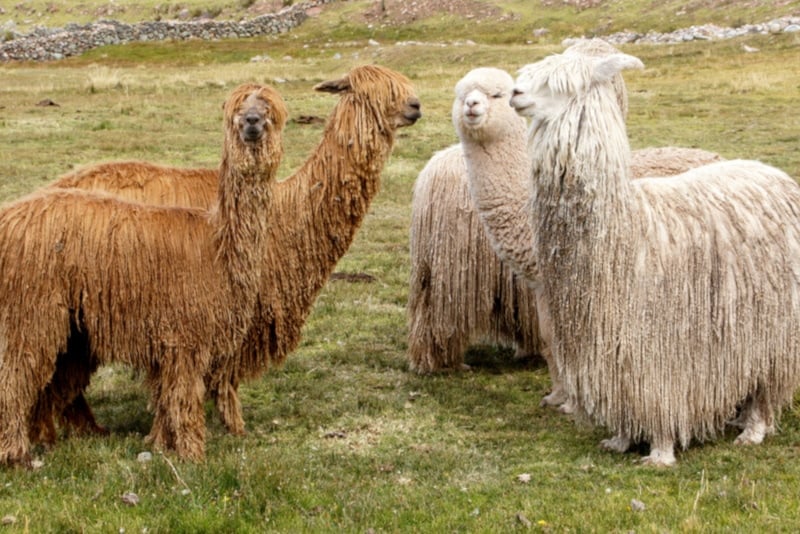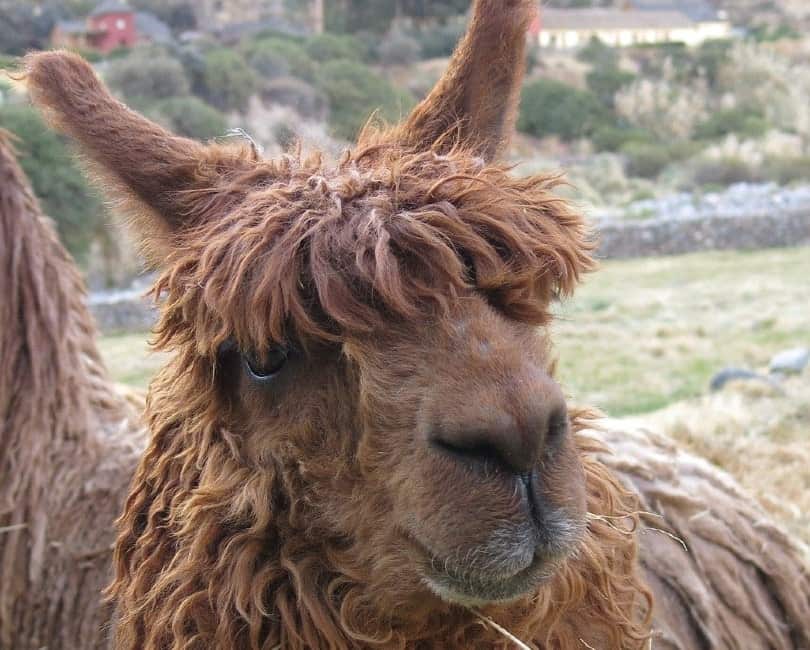The Suri alpaca is a fully domesticated alpaca that originates from the Vicuna (a protected wilderness area in the Andes mountains). The Suri is one of only two breeds of alpaca, with their close relatives being the Huacaya. Suri alpacas are hardy animals and produce a rare and soft fleece that makes them stand out against Huacayas.
Interestingly, out of the millions of alpacas found worldwide, the Suri is thought to make up less than 10% of the alpaca population, which is why they are a rare and unique breed of alpaca to farm or keep as pets. There is so much to learn about this fascinating alpaca breed, and this article has all the information you need!
Click to Skip Ahead:

Quick Facts About Suri Alpacas

| Breed Name: | Suri |
| Place of Origin: | South America |
| Uses: | Farming or pets |
| Macho (Male) Size: | 130–150 pounds |
| Hembra (Female) Size: | 120–145 pounds |
| Color: | Black, fawn, red, grey, white, brown |
| Lifespan: | 12–20 years |
| Climate Tolerance: | Humid regions |
| Care Level: | Moderate |
| Production: | Fleece |
Suri Alpaca Origins
Suri alpacas belong to the camel family that descends from Peru in South America. The Suri alpacas’ ancestors (that closely resembled llamas) were thought to originate from the central plains of North America millions of years ago. These llama-like ancestors migrated to South America to then develop into the Suri alpaca we see today. Many believe that Suri alpacas were first domesticated by Indians living in the Andes mountains, which forms part of the Suri alpaca’s natural habitat.
Suri Alpaca Characteristics
The Suri alpaca has many desirable characteristics. This breed of alpaca is easy to care for and requires less maintenance in comparison to other types of livestock. This alpaca breed can thrive in hot and humid climates as well as cold and snowy conditions thanks to this alpaca breed’s thick insulating fleece. However, this fleece can trap in a lot of heat during the summer months, so they will require a shear before summer starts. Since the Suri alpaca is tolerant to a range of different conditions, it makes this breed easy to farm worldwide if you ensure that they can regulate their body temperature with or without their fleece, depending on the seasons.
The most noticeable characteristic of Suri alpacas is their fleece. This is seen as a luxury item across the world. The fleece’s texture is not the typical crimpy fleece you would see on other breeds of alpacas, instead, it is wavy or straight with a shine and soft texture.
In terms of the Suri alpaca’s temperament, it can vary depending on the individual alpaca’s previous experience with humans. If the alpaca has had negative forms of human interaction, they may be timid and more reserved around their owners or handlers. However, some Suri alpacas are more tolerant of human interaction and can be in the presence of humans without hesitation or fear. This type of alpaca personality is more desirable for owners who plan to keep the Suri alpaca as a pet.

Uses
The Suri alpaca is mainly farmed for their fleece which can be made into a variety of different clothing and commodities for humans. Suri alpacas are mainly imported for their fleece quality, which is why this breed of alpaca can be found in various states where they are bred and farmed for their fleece production or kept as pets in residential areas.
Appearance & Varieties
The luxurious fleece grown by Suri alpacas comes in 22 different colors, which can range from grey to a deep black, and many shades of fawn, reddish-brown, roan, and dark brown. The endless colors that the fleece can come in is another reason besides the quality that the Suri’s fleece is a luxury item. Suri alpacas are also the only breed of alpaca that can produce a true black fleece, which is commonly used for weaving. True black Suri alpaca fleece is expensive and sold as a luxury item in the form of clothing because it is rare for farmers to breed enough true black Suri alpacas to meet the fleece production demand.
Suri alpacas fleece hangs close to their body and has a flowing texture which gives their fleece a flat-sided and luxurious appearance. There are four acceptable lock styles of Suri alpaca fleece, and the locks should start at the skin and be compact, then the spirals of locks can twist in different directions, be straight with a slight hang, or be wavy. The fleece should start locking at the head and run down from the neck across the body until it reaches their legs and hooves. The main sign of quality Suri alpaca fleece is that it should be cool and soft to the touch, with a fine and slightly greasy appearance.
Population/Distribution/Habitat
This alpaca breed is primarily found throughout the Andes mountains of Peru, Chile, and Bolivia. Suri alpacas will typically inhabit mountains with an elevation of 9,800 to 15,750 feet. Here, they live within the grassy shrubland on the mountains—their natural habitat.
Since the demand for Suri alpaca fleece has increased in recent years, you will now find that this breed of alpaca resides across North America, Quebec, Alaska, and Maryland. The Suri alpaca’s excellent climate tolerance has allowed them to be farmed and kept in a variety of different climates around the world.

Are Suri Alpacas Good for Small-Scale Farming?
Suri alpacas are great for both small-scale farmers. You can start with a breeding pair of these alpacas so that they can breed over the years to form a small herd. You’ll need to shear them regularly in the summer months so that they do not overheat, to which the leftover fleece can be weaved and turned into clothing items. Some people also recommend keeping Suri alpacas as pets, because they are easy to raise and generally have an easy-going temperament.
Featured Image Credit: TheusiNo, Pixabay
